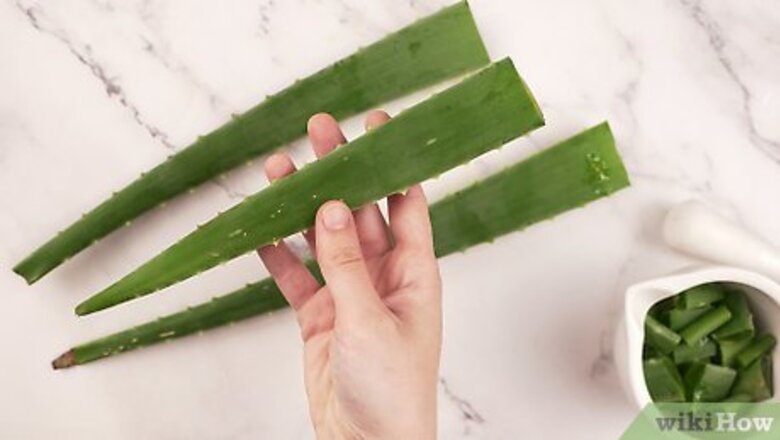
views
X
Trustworthy Source
PubMed Central
Journal archive from the U.S. National Institutes of Health
Go to source
Here, we'll tell you what you need to know to choose the right aloe vera variety, prepare it, and add it to your favorite recipes.
Use the barbadensis Miller variety of aloe vera.
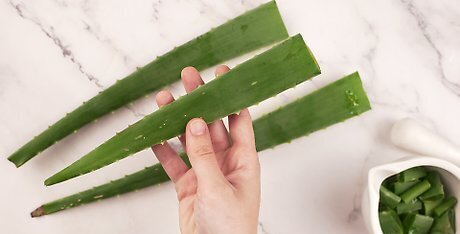
This variety is typically also touted as the most beneficial. Even without the name, you can identify it by its thick, wide, fleshy leaves. The leaves grow upright, and the plant produces yellow flowers. Non-edible aloe vera is referred to as the "chinensis" variety—so if you're getting aloe vera to eat, don't pick that one! Edible aloe vera can also be found in some grocery stores and Latin American markets. If you find it in the produce section, it's the safe-to-eat variety.
Keep portions small or add aloe vera to existing recipes.

Eating a lot of aloe vera can cause severe cramping and diarrhea. Aloe vera is a laxative and can cause some uncomfortable digestive side effects. You might not have a problem with smaller portions, however. Adding small amounts of aloe vera to other recipes can also help minimize this effect. There haven't been a lot of studies done on what constitutes a healthy or safe amount of aloe vera gel to consume, but it isn't much. A little (meaning a quarter-teaspoon or less) goes a long way. If you're buying commercially prepared aloe vera products, follow the label's instructions regarding serving size. These products typically contain less than 10 ppm (parts per million) of aloe-derived material. This isn't something you can eat a lot of! Keep aloe vera as an occasional treat. There is also some evidence that eating aloe vera regularly (for as little as 3 weeks) can lead to acute hepatitis.
Cut the leaves into sections.
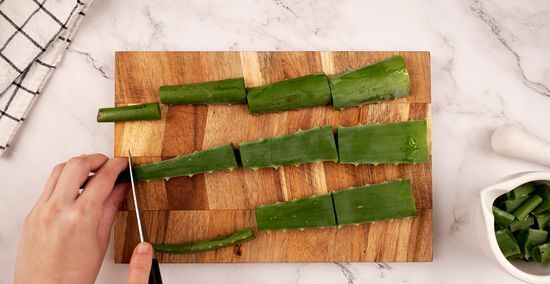
Slice off the spikes then cut the leaf into manageable sections. The spikes, narrow bottom, and top-third of the leaf aren't edible, so you can dispose of these. Then, cut the leaf into 2 or 3 sections so it'll be easier for you to remove the gel. Your sections don't have to be any particular size—you just want them to be manageable as you scrape the gel out. If you want to use the leaves in cooking, you can always cut them into smaller pieces once you get the gel out.
Remove the gel from the leaves.
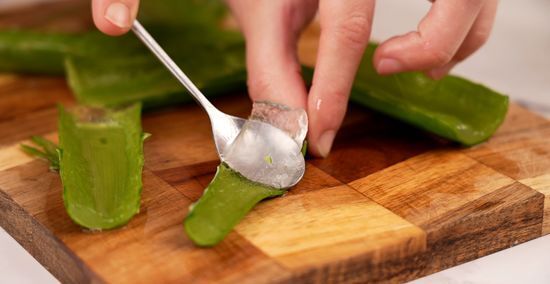
Slice off the flat side of the leaf section to reveal the gel. You'll notice that one side of the leaf is flatter than the other. Slice off that side and you'll see the translucent gel just below the surface. Use a spoon or knife to scrape the clear gel out of the leaf. A vegetable peeler will also work if you have one of those. This process is known as "filleting," and once you get good at it, you'll be able to smoothly remove the gel in one piece. Always rinse off the gel with water to get rid of all the latex (yellow sap). Aloe vera latex is a powerful laxative, so you don't want to eat that!
Rinse the latex off the leaves or gel.
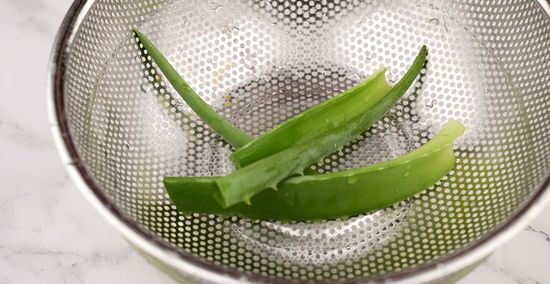
Aloe vera latex (yellow sap) is a powerful laxative. Hold your leaves or gel (whatever you're planning to consume) under cool running water to rinse off the latex. You can place them in a colander so they drain easily—just make sure you move them around so you're thoroughly rinsing all sides. Taking just 1 gram of aloe vera latex can lead to kidney failure and even death. At best, you'll suffer severe abdominal cramps and diarrhea.
Mix the gel with water or juice to drink it.
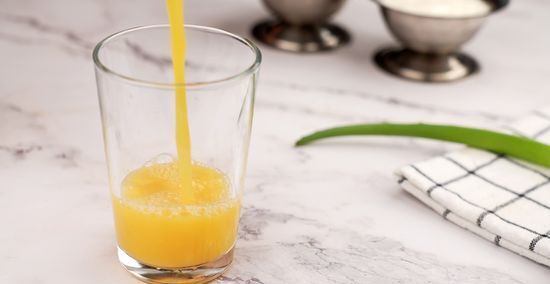
Cut the gel into small cubes so it blends or stirs more easily. Aloe vera gel itself doesn't really have a strong taste, so it likely won't change the flavor of your water or juice very much (if at all). Because of its thickness, it might slightly change the texture and viscosity, though.
Blend aloe gel into a smoothie to disguise it.
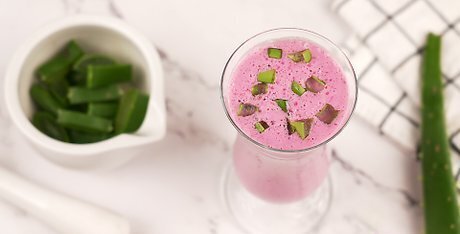
Dice the gel and refrigerate it, then drop it in with your favorite fruits. Cool aloe vera gel has a refreshing taste that works well in smoothies, particularly if you're kicking a recipe up a notch with a little spice. The relatively mild flavor typically won't change the balance of your favorite concoction, although you might want to go easy on the aloe gel at first just to make sure. Sweet fruits that have a stronger flavor can help mask the taste of aloe vera if you find it slightly bitter.
Use chilled aloe gel in chip dips to balance heat.

Cut your aloe gel into cubes and refrigerate overnight, then add to your favorite recipe. Before you mix them up with your other ingredients, rinse your gel cubes off again so they aren't too slippery. The refreshing, "green" taste of aloe vera gel provides a nice cooling effect when mixed with peppers and spices that pack a little heat. Aloe gel doesn't have a very strong taste, so it shouldn't change the flavor of your dip very much. Still, you might find that you need to adjust your seasonings after adding it.
Serve poached aloe gel over yogurt for a milder flavor.

Place cubes in a saucepan with sugar and lime juice. Use 1 cup (about 201 grams) of sugar and the juice of 1 lime. Cook over medium-low heat, stirring occasionally until the aloe vera gel cubes are as firm as grapes and the liquid is no longer slimy. This usually takes around 10 minutes. When your poached aloe gel is done, place the cubes on top of a bowl of your favorite flavor of yogurt and it's ready to eat! Cooked aloe vera has a milder taste, so you might prefer it this way if you find the taste of raw aloe vera too bitter for your palate.
Add aloe vera leaves to salads or salsa for crunch.
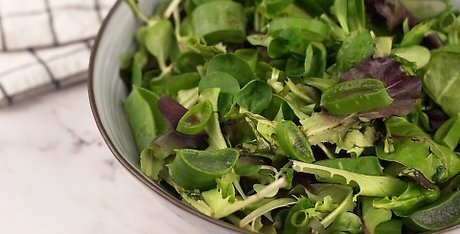
Chop up the leaves or "skin" without the spikes. While the spikes aren't edible, the rest of the leaf is—just make sure you run water over it to rinse it off. Then slice it in thin ribbons, cube it, or grate it. Aloe vera has a cooling flavor, which makes it a natural fit in spicier salads or salsas that pack a little heat.
Buy commercial aloe vera juice or water.
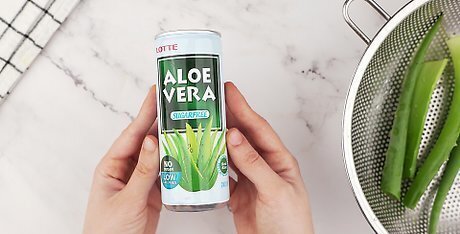
This is the easiest option if you don't want to harvest gel yourself. Removing aloe vera gel from the leaves of the plant isn't difficult, but it does take a little bit of work. If you'd rather go with a ready-made option, most health food stores have bottles of aloe vera juice or water. Aloe vera juice is simply aloe vera gel mixed with fruit juice (usually citrus). Check the label to see what's included in the drink before you buy it. You can drink the juice or water straight from the bottle or mix it into your favorite smoothie.
Watch for uncomfortable side effects.

Eating aloe vera can cause diarrhea and cramping. It can also cause skin irritation or hives, especially if you have an allergy to plants in the lily family, such as onions or tulips. If you notice any of these side effects, stop eating aloe vera immediately. Don't eat aloe vera if you're pregnant or nursing. It could harm your baby. Since aloe vera is also a laxative, it might interfere with your body's ability to absorb any medications you're taking. If you're on a medication for a chronic condition, it's a good idea to talk to your doctor before you eat or drink aloe vera.

















Comments
0 comment